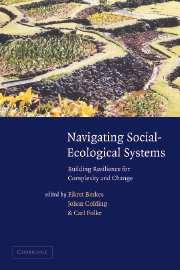Book contents
- Frontmatter
- Contents
- List of contributors
- Preface
- Acknowledgements
- Foreword: The backloop to sustainability
- 1 Introduction
- Part I Perspectives on resilience
- Part II Building resilience in local management systems
- 5 The strategy of the commons: history and property rights in central Sweden
- 6 Management practices for building adaptive capacity: a case from northern Tanzania
- 7 Living with disturbance: building resilience in social–ecological systems
- Part III Social-ecological learning and adaptation
- Part IV Cross-scale institutional response to change
- Index
- References
6 - Management practices for building adaptive capacity: a case from northern Tanzania
Published online by Cambridge University Press: 13 August 2009
- Frontmatter
- Contents
- List of contributors
- Preface
- Acknowledgements
- Foreword: The backloop to sustainability
- 1 Introduction
- Part I Perspectives on resilience
- Part II Building resilience in local management systems
- 5 The strategy of the commons: history and property rights in central Sweden
- 6 Management practices for building adaptive capacity: a case from northern Tanzania
- 7 Living with disturbance: building resilience in social–ecological systems
- Part III Social-ecological learning and adaptation
- Part IV Cross-scale institutional response to change
- Index
- References
Summary
Introduction
This chapter focuses on management practices in the agroecosystem of Iraqw'ar Da/aw [irakuar da-au], the historical heartland of the agro-pastoralistic Iraqw located in the northern highlands of Tanzania. Iraqw'ar Da/aw has been inhabited since at least the late eighteenth century and is mentioned in early colonial reports for its locally developed soil and water conservation practices (Snyder, 1996). For at least 200 years, soils of limited fertility have sustained relatively high populations compared to surrounding areas, through a highly integrated agro-pastoralistic farming system (Ruthenberg, 1980).
The complexity of an agroecosystem arises primarily from interactions between socio-economic and ecological processes, and the case of Iraqw'ar Da/aw raises questions regarding the sustainability of a linked social–ecological system: why has this ‘island of intensification’ persisted (Widgren and Sutton, 1999)? How does it cope with the dynamics of ecosystem behavior, and how has it handled external social–ecological changes such as the post-independence rural re-settlement program in Tanzania? These social–ecological resilience issues are analyzed in this chapter, with a particular focus on management practices for coping with the dynamics of complex adaptive systems.
Sustainable management of natural resources needs to include the maintenance of biodiversity and of vital ecosystem functions and processes such as cycling of nutrients and water. Management must also include social mechanisms that receive, interpret, and process feedback signals from the ecosystems in an adaptive way (Walters, 1986; Hammer, Jansson, and Jansson, 1993; Folke, Berkes, and Colding, 1998).
- Type
- Chapter
- Information
- Navigating Social-Ecological SystemsBuilding Resilience for Complexity and Change, pp. 132 - 162Publisher: Cambridge University PressPrint publication year: 2002



